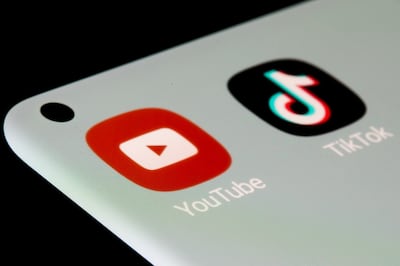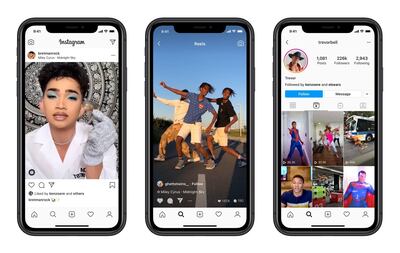The wild popularity of short-form video is usually attributed to our dwindling attention spans. Unable to concentrate on anything for more than a few seconds at a time, we seek out the smallest possible chunk of entertainment before hurriedly moving on to the next.
But length isn't the only reason that videos pick up millions of views; after all, we’ve been able to upload 15-second clips to online video services for many years. It's the creativity, ingenuity and wit fostered by TikTok culture that has brought the audience in. Now, three other companies – YouTube, Snapchat and Instagram – are keen to prise viewers and creators away from TikTok. This has created a four-way battle for the short-form crown.
TikTok is wildly successful and way ahead of the pack. It’s had more than two billion downloads, and its owner, Chinese company ByteDance, has recently been valued at more than $425 billion, by far the most valuable private start-up in the world.
It’s also a pioneer, establishing the blueprint that its rivals now seek to imitate: inspiring and stimulating remix culture, allowing people to use existing songs, videos and memes to create their own work, which in turn can be reused by others.

You want to duet with the original creator of a video? No problem. Take sound from another video to make a parody? Go ahead. While other platforms were still removing content that infringed copyright, TikTok was making a business out of reuse, where every new video provided a source of inspiration to others. It realised that the more videos are made, the more people will be encouraged to join the party.
It's easy for another platform to take TikTok's features and incorporate them into a new product. Establishing a constraint on video length, giving the ability to edit, add effects, stickers and text – these are merely coding problems. But building up an archive of material for people to incorporate in their videos is another matter, and establishing a thriving culture from scratch is almost impossible.
Given that, the service probably best positioned to take it on is the Google-owned YouTube. Its rival service, named Shorts, launched globally last week, after being first trialled in India in the wake of a national ban on TikTok in summer 2020. YouTube, of course, has a massive stable of existing creators with millions of subscribers, a huge repository of licensed music and algorithms skilled at cueing up the next thing to watch. It may yet pose a strong challenge to TikTok’s might.
But in the past few months, each of the four services (including Instagram Reels and Snapchat Spotlight) dangle new lures in the hope that creators and audiences will bite. Back in March, Reels introduced a tool called Remix, very similar to TikTok’s Duets feature, which allows users to incorporate other videos, interact with them and react to them. Snapchat is rumoured to be developing a similar thing.

TikTok hit back in April with a new series of effects that synchronise the movement of video to the beat of the music, and again in May with a Green Screen Duet feature, allowing existing videos to be used as backgrounds to new ones.
YouTube Shorts recently announced the launch of the ability to sample sound from literally any video on YouTube, while TikTok upped the maximum permitted length of a video upload to three minutes. Creators are certainly not short of features to play with.
If these bells and whistles in the apps don’t lever an advantage, maybe hard cash will. Back in November, Snapchat promised to pay out a total of $1 million every day to creators of popular videos. Instagram has made big money offers to TikTok stars to grace the platform, and YouTube has established a $100m Shorts Fund to help creators monetise their output during 2021 and 2022.
TikTok, meanwhile, has announced a multi-billion-dollar global creator fund over the next three years, although opacity over how that money has thus far been distributed has caused some unhappiness in the creative community.
Platform wars aside, the previously unthinkable has come to pass: it is possible to make a living by producing bite-size videos. You just need a flash of inspiration, a modicum of talent and an app. Which one? It’s up to you.
What's the difference between the platforms?
TikTok
- Launched September 2016
- Monthly active users: 1 billion
- 15, 60 or 180-second clips
- Trending sounds and songs list to help your creations stay bang up-to-date
- Access to the creator fund if you have 10,000 followers and have had 10,000 views in the last 30 days
Shorts
- Launched September 2020
- Monthly active users (of YouTube): 2 billion
- Located within the YouTube app
- 15 or 60-second clips
- Huge existing viewership
- Videos easily embedded on any website and platform
Reels
- Launched August 2020
- Monthly active users (of Instagram): 1 billion
- Located within the Instagram app
- 15, 30 or 60-second clips
- As with the rest of Instagram, very hashtag-friendly
- Videos can be shared with close friends or via direct message if preferred
Spotlight
- Launched November 2020
- Monthly active users (of Snapchat): 0.5 billion
- Located within the Snapchat app
- Clips up to 60 seconds long
- Unlike other Snaps, posts don’t expire after 24 hours
- No public comments section





